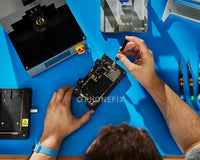As the brain of modern vehicles, the Automotive ECU oversees critical functions engine performance, transmission shifts, emissions control, and even advanced driver-assist systems. When an ECU malfunctions due to soldering issues, soldering rework becomes the last line of defense to avoid costly ECU replacements. But unlike standard electronics repair, ECU rework is fraught with unique challenges.
1. High-Density Component Packaging.
Modern ECUs are packed with miniaturized surface-mount components, including BGA chips, QFP ICs, and resistors capacitors. These components have tiny solder joints that demand extreme precision during rework, even a fraction of a millimeter of misalignment or temperature variation can cause failure. Overheating can melt internal circuitry or create cold solder joints, while too little heat can cause incomplete solder flow.
Use a hot air rework station with temperature profiling, such as QUICK TR1300A Hot Air Rework Station to match the component’s specific heat requirements. For BGAs, invest in X-ray inspection post-rework to verify solder joint integrity.
2. Reliability Under Harsh Vehicle Conditions.
ECUs operate in one of the most unforgiving environments, under the hood, where temperatures swing from -40°C to 125°C, reworked solder joints are often more vulnerable to thermal cycling. Overheating can melt internal circuitry or create cold solder joints, while too little heat can cause incomplete solder flow.
Use lead-free solder alloys with high thermal fatigue resistance that match OEM specifications. After rework, let the ECU run at varying temperatures to stress-test joints before reinstallation.
3. Protecting Surrounding Sensitive Components.
ECUs are densely packed, components like ceramic capacitors, voltage regulators, and EEPROM chips sit millimeters apart. During rework, the high heat from hot air or soldering irons can damage nearby components that aren’t designed to withstand elevated temperatures. Even small resistors may drift in value or burn out if heat spreads beyond the target component.
Use heat-resistant tape to cover nearby components, and attach a small heat sink to temperature-sensitive parts to draw away excess heat. Work in short bursts avoid holding the hot air nozzle in one spot for too long.
4. Fault Localization.
Before rework even begins, technicians face a major challenge that identifying which solder joint is faulty. Visual inspection only catches obvious defects. Many ECU issues stem from hidden cold joints or micro-cracks in solder that aren’t visible to the naked eye.
Start with oscilloscopes to narrow down the faulty circuit. For hidden joints, use X-ray inspection to spot micro-cracks or cold joints.
5. Material Compatibility.
Original ECU manufacturing uses specific solder types, fluxes, and PCB materials that work together to prevent corrosion and ensure long-term reliability. Using incompatible materials during rework can create new problems, even if the soldering itself looks perfect.
Repair components on an ECU is a rewarding skill that can save you significant repair costs. While DIY ECU component repair is cost-effective, complex repairs involving microcontrollers or multilayer boards may require professional expertise. If you're unsure about a repair, consider consulting a professional to avoid further damage to the ECU, which could lead to costly replacements.
5 Stakes in Automotive ECU Soldering Rework










